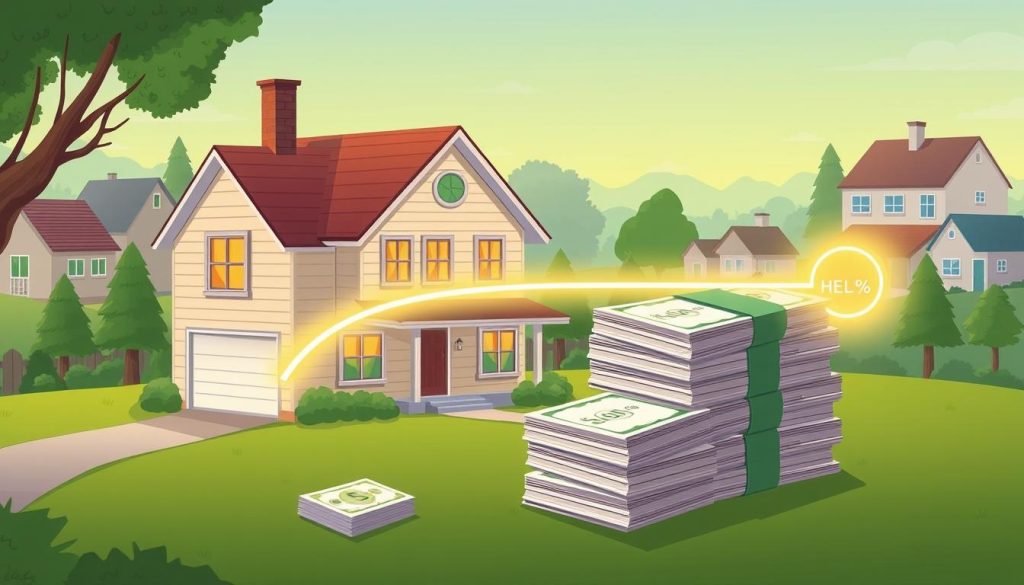Home Equity Lines of Credit (HELOCs) are now a key tool for smart financial experts. This guide will give you all you need to know about HELOCs. You’ll learn how to use this powerful financial tool for your clients. We’ll cover everything from home equity basics to how to qualify for a HELOC12.
Topics include financial planning, debt consolidation, improving homes, and investing in real estate. This guide is packed with important info for financial pros.
Key Takeaways
- Understand the factors that influence home equity and how to calculate it
- Explore the benefits of HELOCs, including flexibility, lower interest rates, and potential tax deductions
- Learn the qualification requirements for a HELOC, such as minimum home equity, credit score, and debt-to-income ratio
- Discover how HELOCs can be utilized for home improvements, debt consolidation, and real estate investing
- Gain insights into the role of income statements and financial reporting in HELOC applications
- https://tunekong.com/diy-home-decor-masterclass-transform-any-space-with-simple-stunning-ideas-21/
Understanding Home Equity and How It Works
Home equity is a valuable asset that can help with your financial needs. It’s the difference between your home’s market value and what you owe on your mortgage3. As you pay down your mortgage and your home’s value goes up, your equity grows. This gives you more financial flexibility.
Home Equity: The Difference Between Your Home’s Value and Mortgage Balance
Your home equity is based on your home’s purchase price and its current market value3. When you buy a home, your down payment sets your equity right away. For instance, a $300,000 home with a 20% down payment of $60,000 starts with $60,000 in equity3. As you pay off your mortgage and your home’s value increases, your equity also grows3.
Factors Influencing Home Equity: Purchase Price, Market Value, and Remaining Mortgage
Your home equity depends on your purchase price, your home’s current market value, and your mortgage balance3. If your home’s value goes up by $100,000 and you’ve paid down $15,000 of your mortgage, your equity would be $175,0003. But if your home’s value drops or your mortgage balance goes up, your equity will decrease3.
| Metric | Value |
|---|---|
| Percent of U.S. mortgaged homes that are “equity-rich” | Data from ATTOM “Q4 2023 U.S. Home Equity & Underwater Report”4 |
| Home equity collectively held by U.S. borrowers as of December 2023 | $10.3T, with $10.3T considered “tappable,” allowing withdrawal while maintaining an 80% combined loan-to-value ratio. Source: ICE Mortgage Monitor Report February 20244 |
| Average gain in home equity for U.S. mortgage-holding homeowners in the fourth quarter of 2023 compared to the previous year | $1.3 trillion, resulting in an average gain of $24,000 in ownership stake per borrower. Source: Corelogic’s Homeowner Equity Insights4 |
Understanding home equity is key to making smart financial choices. This includes looking into home equity lines of credit (HELOC), refinancing, or keeping an eye on your home’s value345.
Benefits of a Home Equity Line of Credit
A Home Equity Line of Credit (HELOC) gives homeowners many financial benefits. It lets you use funds as you need them, often at lower interest rates, and might even offer tax deductions. This makes a HELOC a great option for covering expenses, improving your home, or paying off debt.
Flexibility: Access Funds as Needed for Ongoing Expenses or Projects
HELOCs are known for their flexibility. Unlike a lump-sum loan, you can take money as you need it, up to a set limit6. This is great for ongoing costs or big projects. You only borrow what you need, avoiding a large loan upfront.
Lower Interest Rates Compared to Other Consumer Loans
HELOCs usually have lower interest rates than credit cards or personal loans6. They’re secured by your home’s equity, so lenders offer better terms6. Plus, HELOCs often have no closing costs, unlike home equity loans which can have costs of 2% to 5% of the loan6.
Potential Tax Deductions on Interest Paid
The interest on a HELOC might be tax-deductible, depending on how you use the money6. This can be a big plus for homeowners, helping to reduce the cost of borrowing. But, it’s wise to talk to a tax expert to see how it applies to you.
| HELOC Benefits | Details |
|---|---|
| Flexibility | Access funds as needed for ongoing expenses or projects |
| Lower Interest Rates | Typically lower than other consumer loans due to home equity |
| Potential Tax Deductions | Interest paid may be tax-deductible, depending on use of funds |
“A HELOC can provide homeowners with the financial resources they require for a variety of purposes, including ongoing expenses, home improvements, and debt consolidation.”
In summary, a HELOC is a powerful financial tool for homeowners. It offers flexibility, savings, and tax benefits. By thinking about your financial needs and goals, you can decide if a HELOC is right for you6.
How to Qualify for a Home Equity Line of Credit
Getting a Home Equity Line of Credit (HELOC) can be a smart financial step. It gives you access to the equity in your home. But, lenders have certain rules to check if you qualify for a HELOC. Let’s look at what you need to meet these requirements.
Minimum Home Equity Requirements
Lenders check how much equity you have in your home first. You usually need at least 20% equity to get a HELOC7. This means your home’s value must be at least 20% more than your mortgage balance.
Credit Score and Credit History Evaluation
Lenders also look at your credit score and history to see if you’re creditworthy. They usually want a credit score of 700 or higher7. Your credit history should show you’ve borrowed responsibly and paid on time.
Income, Debt-to-Income Ratio, and Employment Status
Your income, debt-to-income ratio (DTI), and job status matter too. Lenders like a DTI ratio between 43% and 50%789. They also want proof of steady work or steady income to make sure you can pay back the HELOC.
Knowing these key points can help you get ready financially. This increases your chances of getting a HELOC that fits your needs. 
Utilizing a HELOC for Home Improvements and Renovations
A Home Equity Line of Credit (HELOC) is a great way to finance home improvements and renovations. It lets homeowners get funds as needed for projects like kitchen and bathroom remodels, or energy-efficient upgrades10. HELOCs have tax-deductible interest potential and can increase your home’s value with smart improvements10.
Financing Kitchen, Bathroom, and Other Remodeling Projects
Using a HELOC for home improvements is great for financing kitchen, bathroom, and other projects11. HELOCs have lower interest rates than other loans, making them a budget-friendly choice11. Plus, the interest on a HELOC for home improvements might be tax-deductible, adding to the financial benefits10.
Increasing Home Value Through Improvements
Home improvements can increase your property’s value11. With a HELOC, you can get the funds for renovations that boost your home’s resale value, like kitchen and bathroom updates, or energy-efficient upgrades10. This is great for homeowners selling soon or building long-term equity.
Flexible Financing for Multi-Phase Projects
For big, multi-phase projects, a HELOC offers flexible funding10. Unlike a fixed loan, a HELOC lets you draw funds as needed, making complex renovations easier to manage11. This is perfect for homeowners who like to work on projects step by step or need to adjust plans during the process.

Financing home improvements with a HELOC is a smart choice. It uses your home’s equity to fund your projects, potentially increasing your home’s value, and lets you work on projects at your pace1011.
income statements
A HELOC is great for paying off high-interest debts like credit card balances or personal loans. You can use your home’s equity to get funds at a lower interest rate. This way, you can save money on interest, make one easy monthly payment, and maybe even boost your credit score.
Simplifying Monthly Payments with a Single HELOC Payment
With a HELOC, you can combine your high-interest debts into one easy payment. This makes budgeting simpler and keeps you on track with just one due date. HELOCs often have lower interest rates than credit cards or personal loans, which can save you a lot over time.12
Potential for Improved Credit Utilization Ratio and Credit Score
Using a HELOC to clear high-interest debts can also help your credit score. Paying off credit card balances increases your available credit and lowers your credit use ratio. This can make it easier to get loans or credit cards in the future12.
“Consolidating high-interest debt with a HELOC can save you money on interest payments and simplify your monthly finances. It’s a smart strategy that can also benefit your credit score.”
But, be careful when using a HELOC for debt consolidation. Make sure you have a solid plan for making payments on time to avoid getting back into high-interest debt. By using your home’s equity wisely, you can take charge of your finances and aim for a stable financial future.
Conclusion
In this guide, we looked at Home Equity Lines of Credit (HELOCs) for financial pros. We covered how to get a HELOC and use it for home fixes, paying off debt, and investing in real estate. HELOCs are a strong financial tool if used wisely. Understanding income statements and other reports helps clients make smart choices and use their home equity well.
The income statement tracks a business’s performance, often monthly or quarterly13. It’s used by company leaders, the board, investors, creditors, and rivals13. With income statements, you can help clients manage their money better and spot ways to get ahead financially.
Your job as a financial expert is to guide clients through HELOCs and home equity. By keeping up with financial reports, you can help clients use their home equity to reach their financial goals. Remember, a HELOC is powerful, but it needs careful handling and to match your clients’ long-term financial plans.
FAQ
What is a Home Equity Line of Credit (HELOC)?
A HELOC lets you use your home’s equity for loans. Equity is the value of your home minus what you owe on your mortgage. You can borrow against this equity and get funds when you need them.
What are the benefits of a HELOC?
A HELOC offers flexibility in getting funds, lower interest rates, and you might be able to deduct the interest. This depends on how you use the money.
What are the typical requirements to qualify for a HELOC?
To get a HELOC, you need at least 20% equity in your home. You also need a good credit score and history, stable income, a low debt-to-income ratio, and steady employment.
How can a HELOC be used for home improvements and renovations?
A HELOC can fund home improvements and renovations. This includes kitchen and bathroom updates, additions, and energy-efficient upgrades. It’s great for big projects that need several phases.
How can a HELOC be used to consolidate and pay off high-interest debts?
Use a HELOC to get funds at a lower interest rate. Then, pay off high-interest debts like credit cards or personal loans. This can save you money, simplify payments, and help your credit score.
How do income statements and financial reporting play a role in the HELOC application process?
Lenders look at your income statements and financial reports to check if you can handle the HELOC. Knowing how these documents are important can help you prepare a strong application.

